Last updated on
Delving into pantry cooling ideas is vital because an adequately cooled pantry can extend the shelf life of your food items and save you money in the process.
I’ve designed unique illustrations for these ideas. I hope you get inspired!
Stepping into your pantry to grab a quick snack on a hot day shouldn’t feel like diving into a sauna. Cultivating coolness in the pantry is a union of science, style, and a dash of creativity.
Of course, the internet is teeming with familiar ideas – wire racks, ventilation, and positioning away from appliances, to name a few. There’s no doubt these strategies have proven their worth, and we’ll provide resources to the very best of them at the end of this article.
But our aim here is to break away from the threadbare norm, to introduce you to fresh and exciting paths less trodden. We’ve reappraised the issue from different angles and have crafted an unmatched list of unique pantry cooling solutions.
This isn’t just a tired retelling – it’s a treasure trove of innovative concepts waiting to turn your pantry into a cool haven. So, let’s highlight the unexplored, the unexpected, and the truly unique. Let the adventure commence!
Consider a Pantry Cooling System
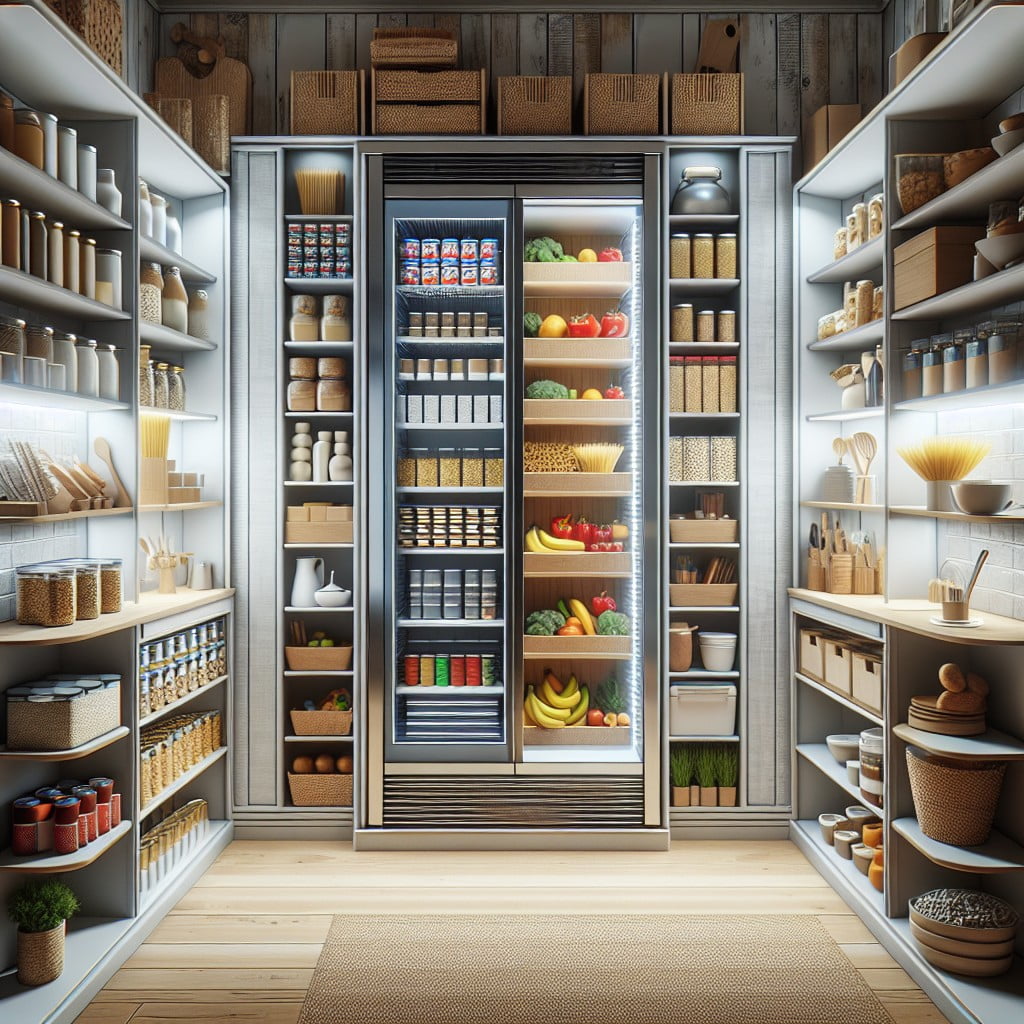
There are a number of factors to strategize when contemplating a cooling system for your pantry. First, assess the pantry’s size and location, as these will influence the type and power of cooling units required. Appliances, such as small vented air conditioning systems or wall units, serve as viable options for larger pantries.
For smaller storage areas, even simple solutions like correctly placed fans can enhance circulation, reducing ambient temperature. Be cautious of noise levels from any electric system, ensuring your daily routine remains undisturbed. Moreover, consider energy efficiency while selecting any cooling devices to manage power bills skillfully.
Remember, a cooling system’s primary role should be to maintain consistent temperatures, preferably on the lower end of the spectrum. This helps in enhancing the shelf-life of your stored items, curbing bacteria growth, managing humidity, and ensuring the pantry remains a pleasant space within your home.
Understanding the functionality behind cooling systems will help you make a more informed choice, keeping in mind that the system should ideally be easy to operate, maintain, and ultimately serve the purpose of extending the life of your pantry goods.
The Importance of Pantry Design
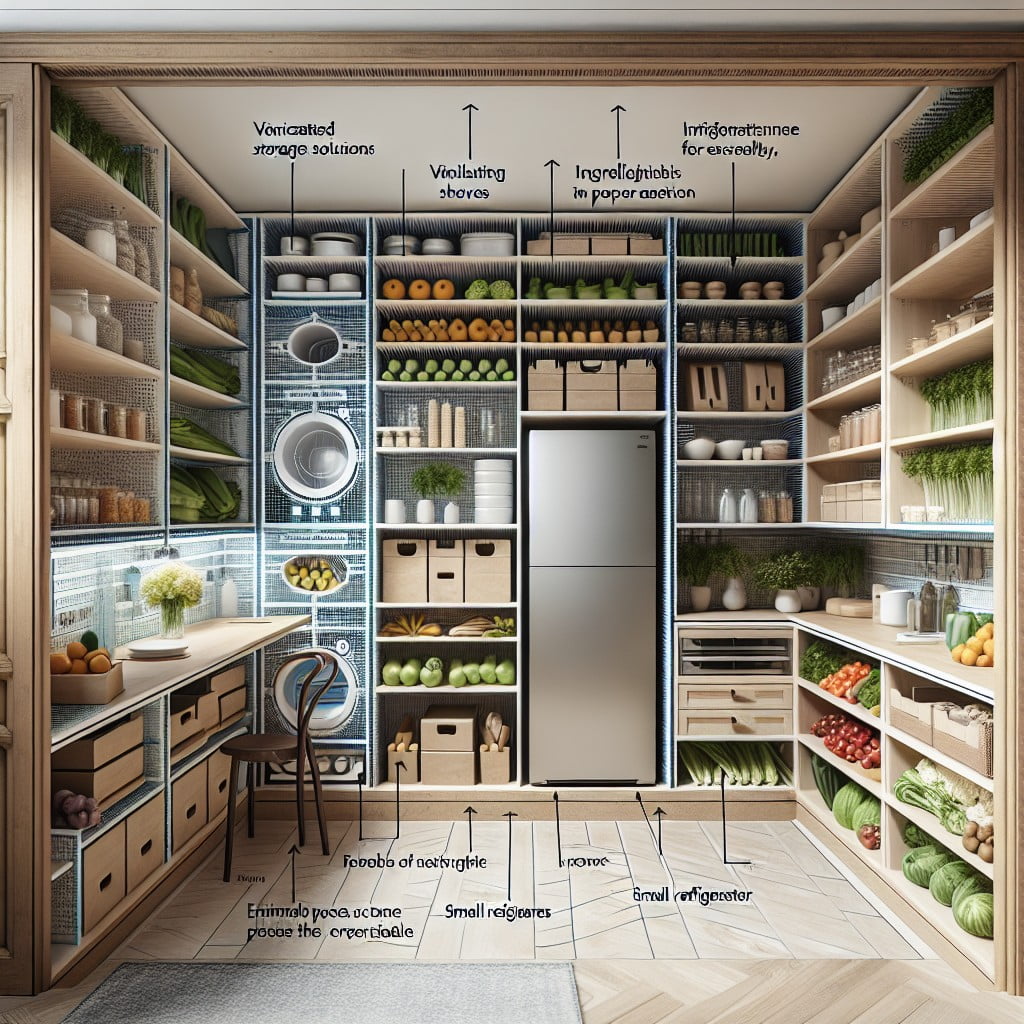
Design plays a vital role in the effectiveness of pantry cooling. A well-planned one enables easy airflow, reduces heat build-up, and promotes a cooler environment. Consider these crucial elements:
- Large vents: These allow for better air circulation, helping keep temperatures down and ensures perishable food items stay fresh longer.
- Light-colored interiors: Light hues reflect heat rather than absorb, contributing to a cooler pantry environment.
- Strategic layout: Placing heat-generating items like appliances away from fresh produce can significantly impact heat distribution and cooling efficiency.
- High ceilings: They provide extra space where hot air can rise, keeping the main pantry area cooler.
- Insulated walls: This feature reduces heat transfer from outside, maintaining a steady inside temperature.
- Separate zones: Design different areas for different items – fruits, vegetables, canned goods, etc. each have distinct temperature needs.
Remember, effective design doesn’t have to compromise aesthetic appeal. A cool pantry can also be a visually pleasing pantry!
A Guide to Pantry Cooling Accessories
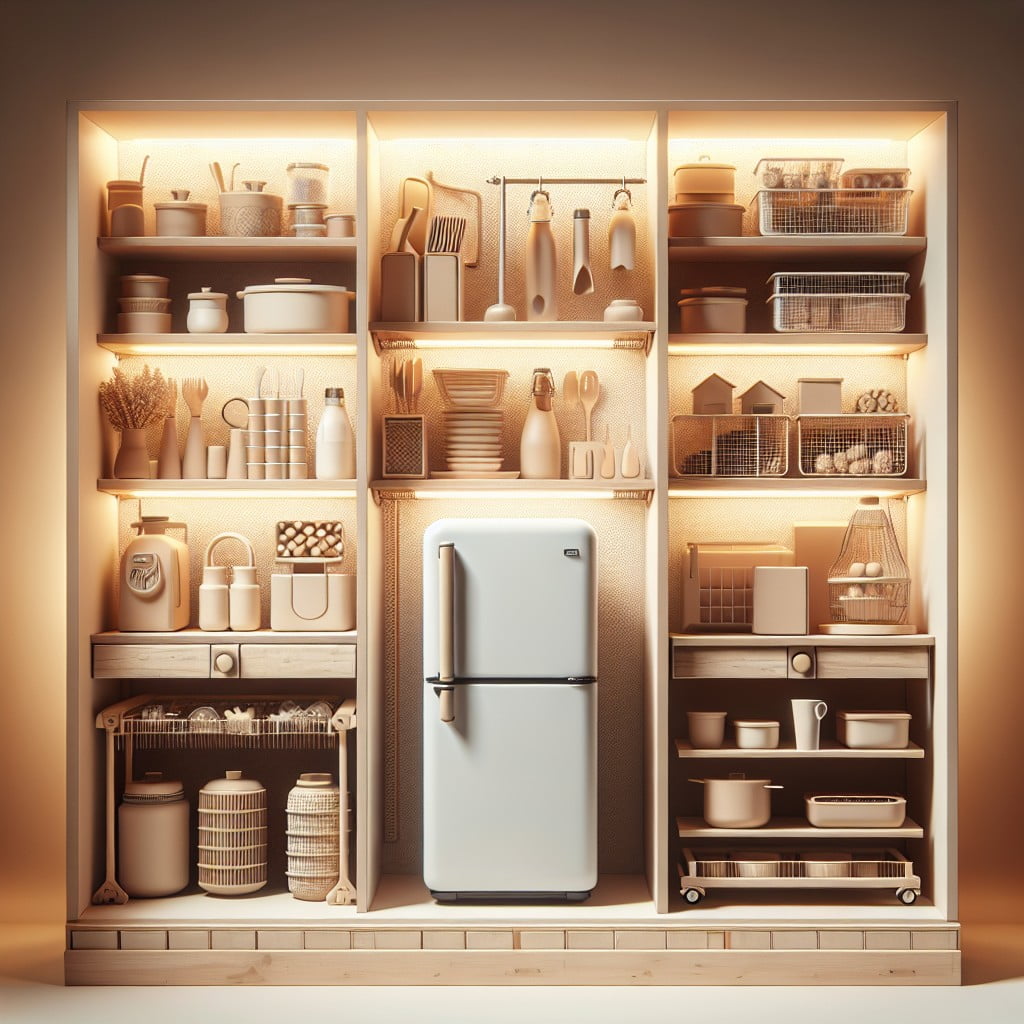
Understanding the right accessories is key to achieving an optimally cooled pantry. Let’s explore some effective tools.
Firstly, small, quiet fans can be instrumental in circulating air, preventing hot spots and reducing the chance of food spoilage. Position them strategically for the best effect.
Next, dehumidifiers. They can be invaluable in high-humidity areas, by reducing excess moisture, which in turn lowers the pantry’s temperature.
Thermometers are also an accessory that should not be overlooked. They allow for regular monitoring of temperature fluctuations, aiding in the detection of potential issues promptly.
Finally, consider insulated curtains or thermal shades for your pantry. They work wonders to block out the heat from sunlight, if your pantry has windows, keeping the room cooler.
Remember, pantry cooling is not a one-size-fits-all strategy. What works for one household might not work for another, it’s about finding what suits your pantry best. It’s all about balancing your chosen appliances with other cooling techniques.
Efficient Pantry Organization for Optimal Cooling
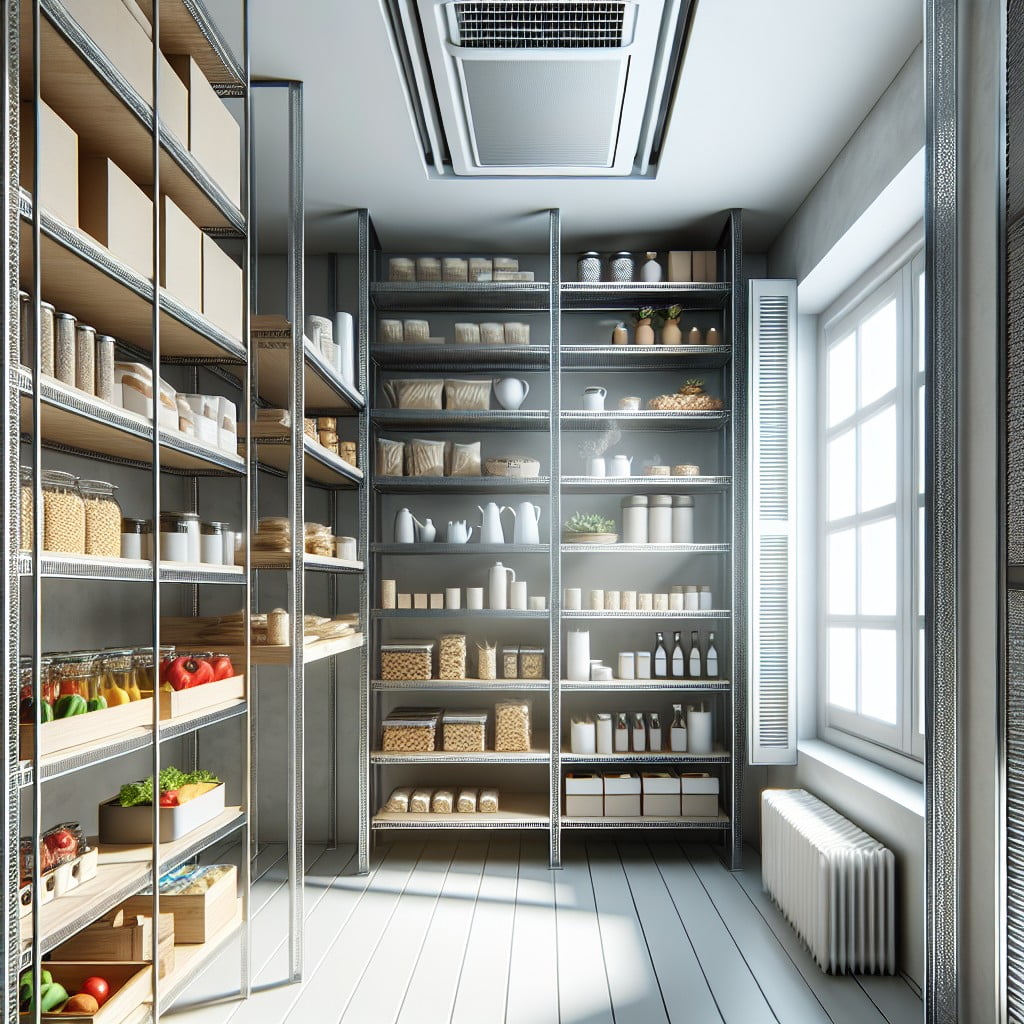
Creating an efficient and cooling-friendly pantry can be as simple as opting for thoughtful organization strategies. Start by ensuring that your pantry items are well-spaced, allowing air to circulate freely between them.
Consider set aside sections for different types of foods to maximize effectiveness of overall cooling. For example, canned goods retain their coolness longer and could potentially be stored closer to the pantry’s warmer areas, while delicate items such as chocolates may need a cooler spot.
Use stackable containers to increase air circulation and reduce pockets of trapped heat. Also, opt for open-sided shelving instead of closed cabinets, as the latter can trap heat and raise the overall temperature.
Lastly, remember to rotate your food supply regularly. Older items should be placed at the front to be used first, opening up more space for air to circulate and helping to maintain a steady, cool temperature.
Efficient organization is not just about neatness, but a crucial tactic in maintaining the optimal pantry cooling.
Airflow Optimization Techniques for Pantries
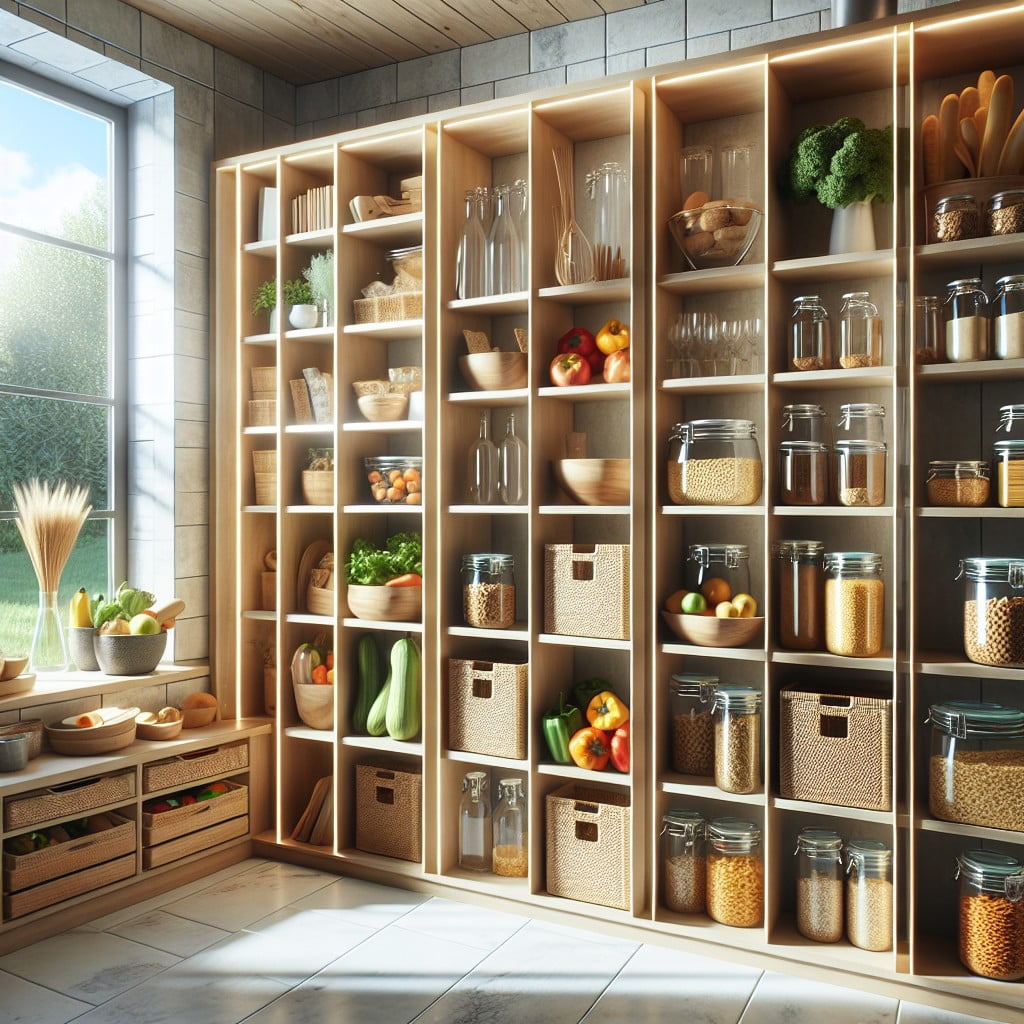
Maintaining a circulating breeze can significantly aid in pantry cooling. Firstly, installing a vent, especially near the vicinity of the pantry ceiling, can help exhaust warm air that naturally rises. Secondly, consider fans, particularly exhaust fans, to generate constant airflow and prevent hot spots. Position these near the floor to draw in cool air.
Cross-ventilation is a useful concept, achieved by having openings at opposite ends, allowing ambient air to pass through. To enrich this process, strategically placing perforated pantry shelves or wire racks can enhance air movement across all areas.
Finally, remember: a cluttered pantry impedes airflow. Regular decluttering and smart arrangement of pantry items is crucial to ensure the free circulation that contributes to a cooler pantry.
Energy-Saving Tips for Pantry Cooling
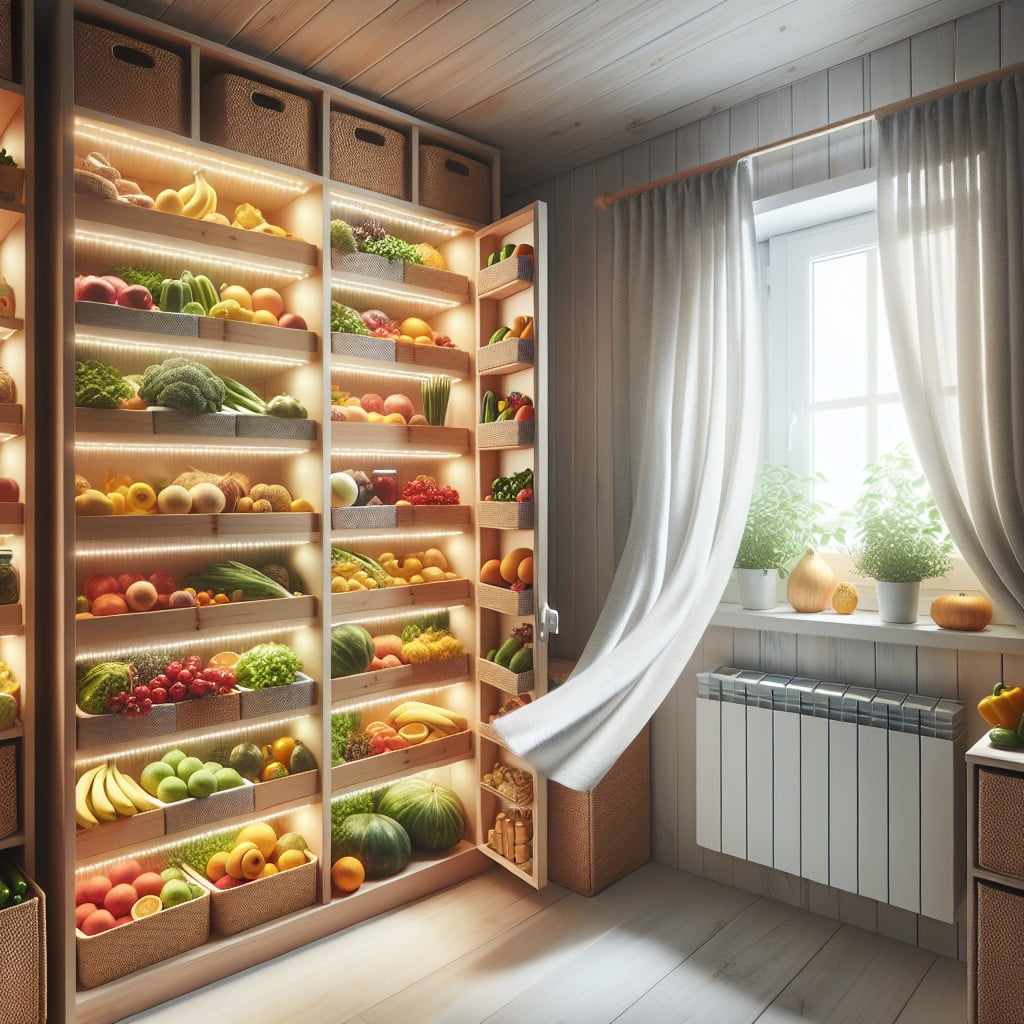
To save energy while maintaining a cool pantry, take these steps:
1. Upgrade to Energy-Efficient Appliances: If using cooling units, energy-star labelled models are designed to consume less electricity.
2. Install a Digital Thermostat: These allow you to better manage temperature and energy usage.
3. Opt for LED Lighting: LEDs produce less heat than traditional lights reducing the need for added cooling.
4. Use Weather Stripping: Sealing gaps around the door can prevent the loss of cool air, lowering the need for adjustment.
5. Use of Sufficient Ventilation: Improving the pantry’s airflow can reduce energy use while maintaining lower temperatures.
6. Insulate Walls: Proper insulation of pantry walls can keep cool air in and hot air out, lessening the cooling energy demand.
Remember, implementing a combination of these tactics can amplify their individual effects, making your pantry cooling efforts more energy efficient and effective.
Understanding Pantry Microclimates
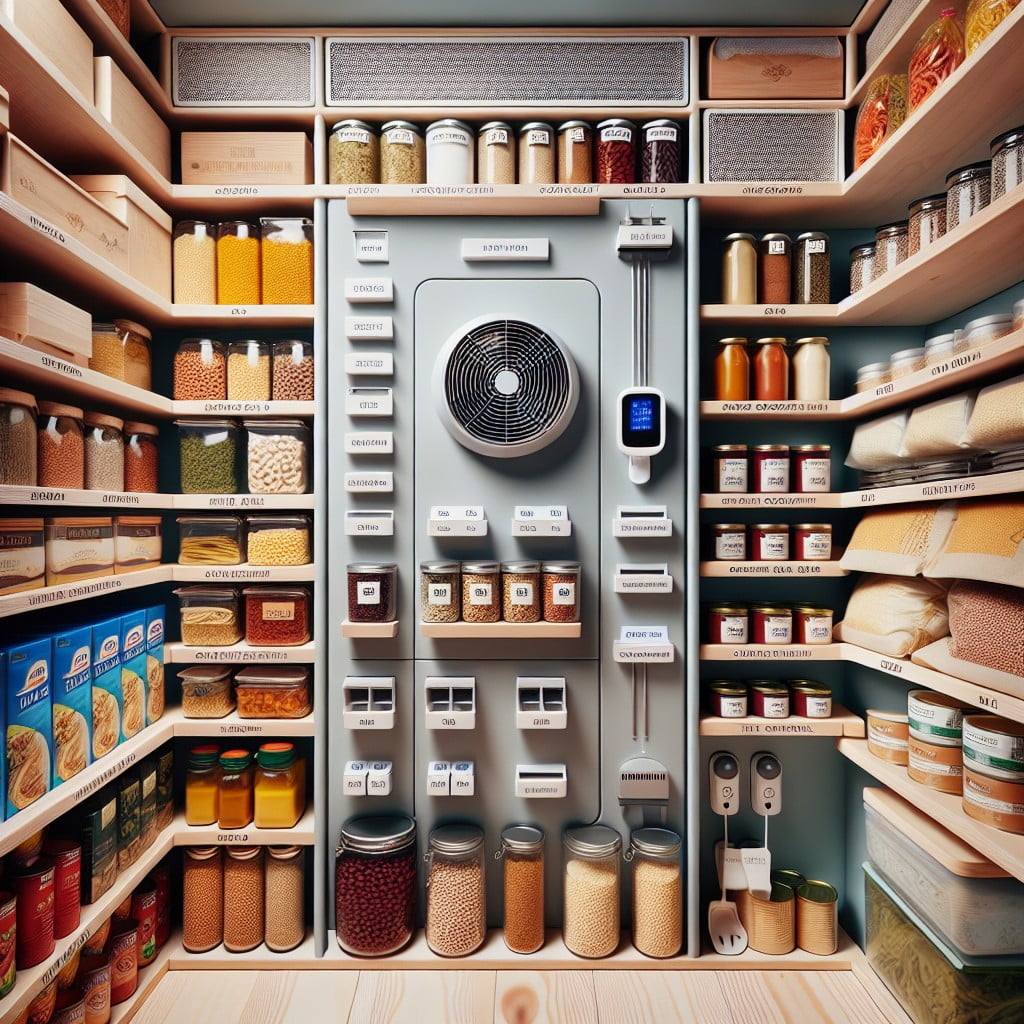
Pantries, like the larger environment they inhabit, consist of microclimates—an ensemble of conditions concerning temperature and humidity affected by varying factors. Different food items require various conditions for optimal storage, so it’s essential to map out these microclimates within your pantry.
1. Upper Shelves: Often the warmest area, suitable for storing canned goods and baking ingredients that won’t get affected by heat.
2. Middle Shelves: Perfect for pasta, cereals, and other non-perishables, as it typically maintains a moderate temperature.
3. Lower Shelves/ Floor Area: The coolest part of your pantry. Ideal for root vegetables, onions, and garlic which require cooler, darker conditions.
4. Near The Door: A spot prone to temperature fluctuations—ideal for storing items that don’t need stringent temperature control.
By recognizing these zones, you can optimize your pantry space for precise food storage, improving longevity and reducing wastage.
Automated Pantry Cooling Methods
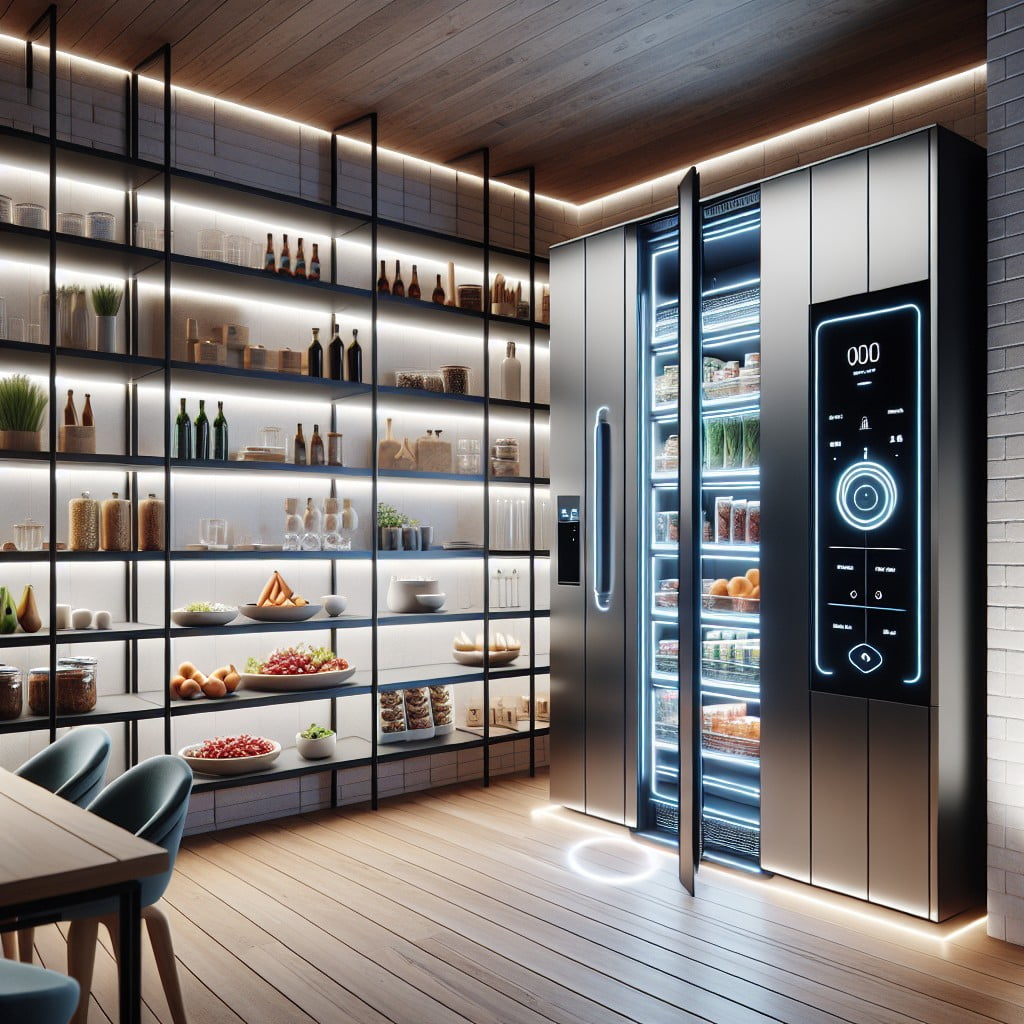
Investing in technology can revolutionize the traditional pantry cooling landscape. High-tech systems, such as a temperature-controlled exhaust fan, serve as a cooling mechanism when the pantry temperature exceeds a preset limit. They automatically kick in, expelling warm air and replacing it with cooler air from other parts of the home or outside, preserving the freshness of your pantry items.
Another method is the use of a digital thermostat for maintaining an accurate, constant temperature. Integrated with smart home technology, these can be controlled remotely and adjusted based on changing outside temperatures or the specific items in your pantry.
Last but not least, there are smart shelves available on the market that come equipped with integrated cooling systems. These shelves can monitor and control the temperature of each individual compartment, helping to maintain the stability of more temperature-sensitive food items.
Summer Vs Winter: Seasonal Pantry Cooling Tips
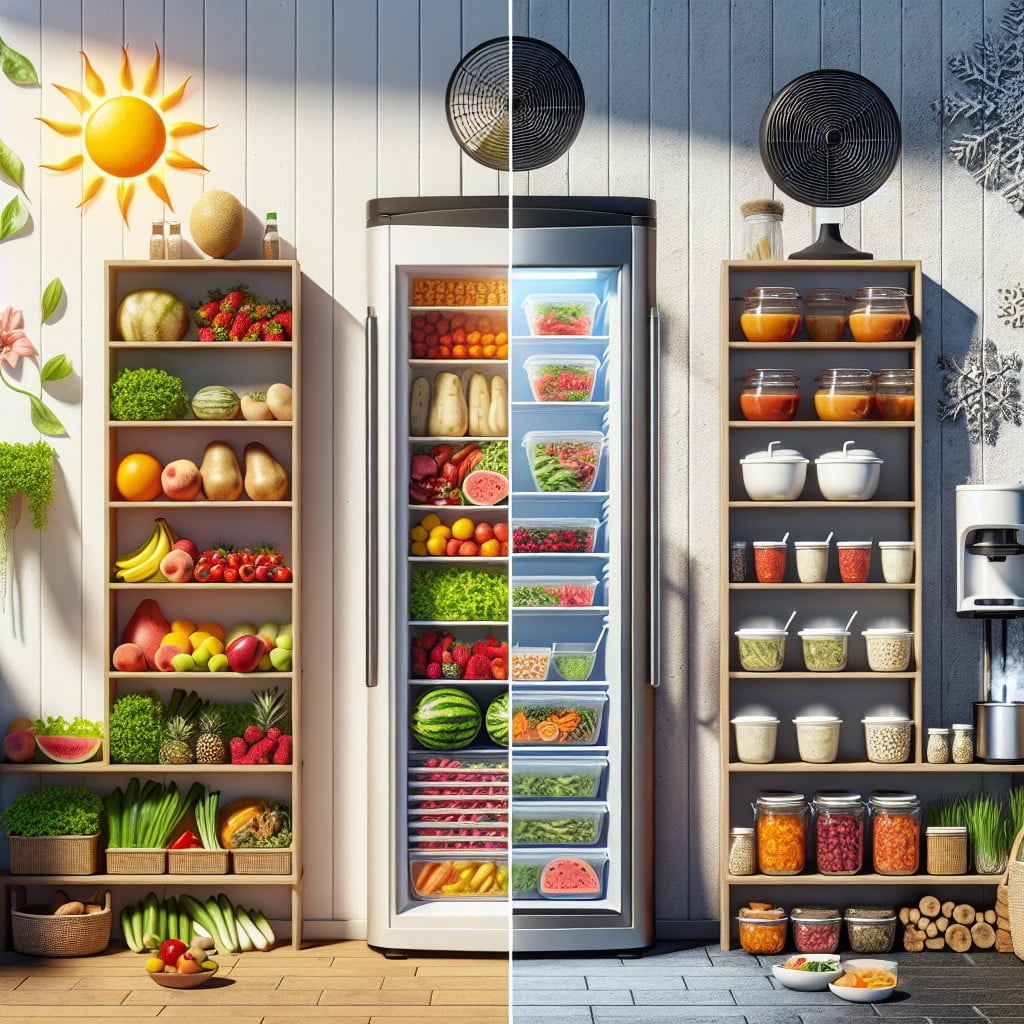
During summer, higher temperatures can potentially spoil food stored in pantries. To combat this, ensure the pantry is well shaded, aligning vents to facilitate good airflow. More regular checks on pantry conditions might be necessary to prevent food spoilage.
In contrast, the colder winter months can freeze food if precautions aren’t taken. Keep the pantry doors sealed tightly to prevent the ingress of cold air. Using a small space heater or heating mat can keep the room temperature optimal. However, be wary of creating too warm an environment which can also lead to food spoilage.
Both seasons demand an understanding of the pantry’s ventilation and insulation characteristics. The cooling methods should adapt to the changes in weather for the best results in controlling pantry temperatures year-round.
Ideal Pantry Materials for Better Cooling
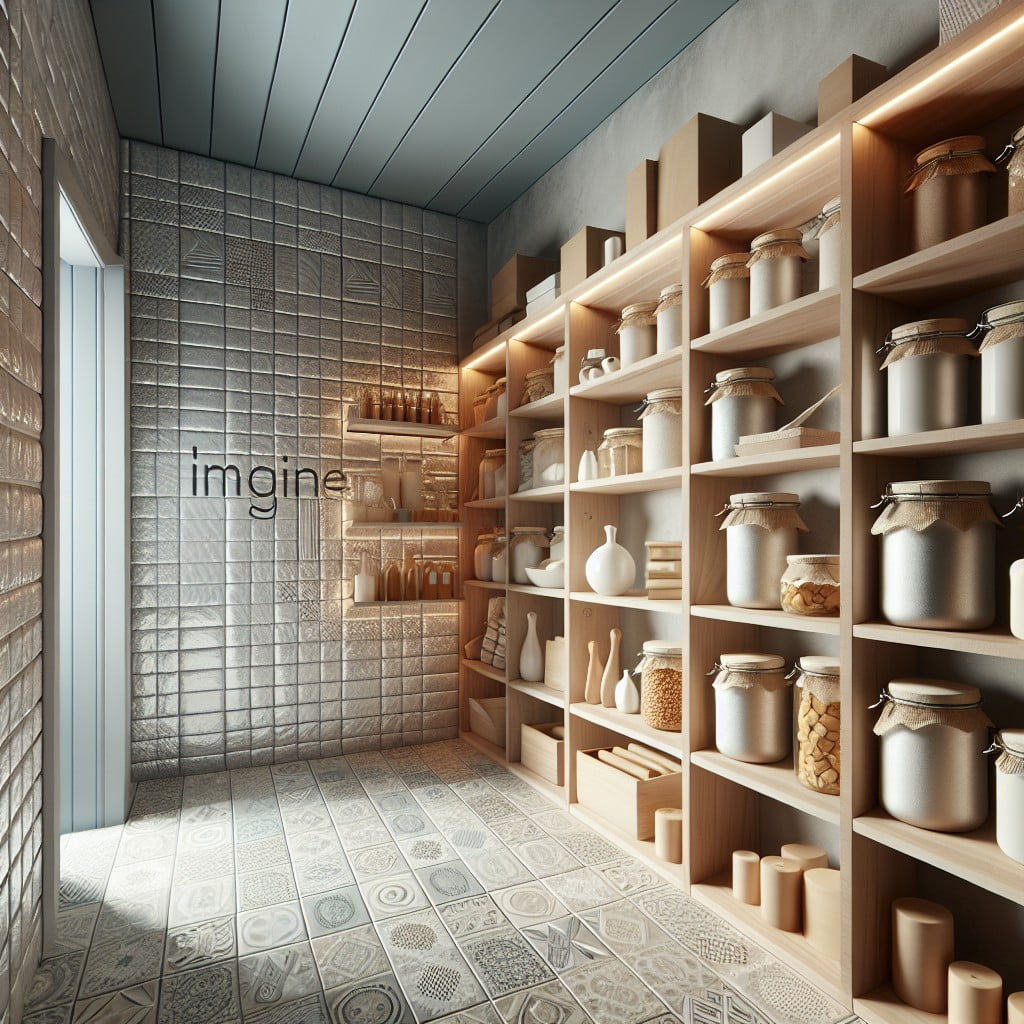
Choosing the right materials for your pantry can significantly contribute to its cooling efficiency. Traditional wooden shelving, for instance, is not only aesthetically pleasing but also helps maintain cooler temperatures due to its excellent insulation properties.
Mirroring this, opting for concrete or stone flooring, known for their cool nature, can serve dual-purpose; providing a natural coolness while also adding a rustic feel. Avoid using metals which can conduct heat and increase the temperature.
Utilizing materials like doors and walls that provide adequate insulation play a crucial role too. Insulated, solid-core doors can prevent warm air from seeping into the pantry. As for walls, incorporating thermal insulation will make a notable difference in maintaining cool temperatures inside the pantry.
Remember, lighter colors reflect light and heat, making them a smart choice for both the interior and exterior finish. While choosing pantry materials, consider their function alongside their form to find a balance between aesthetics and cooling efficiency.
Cooling Impact of Pantry Location
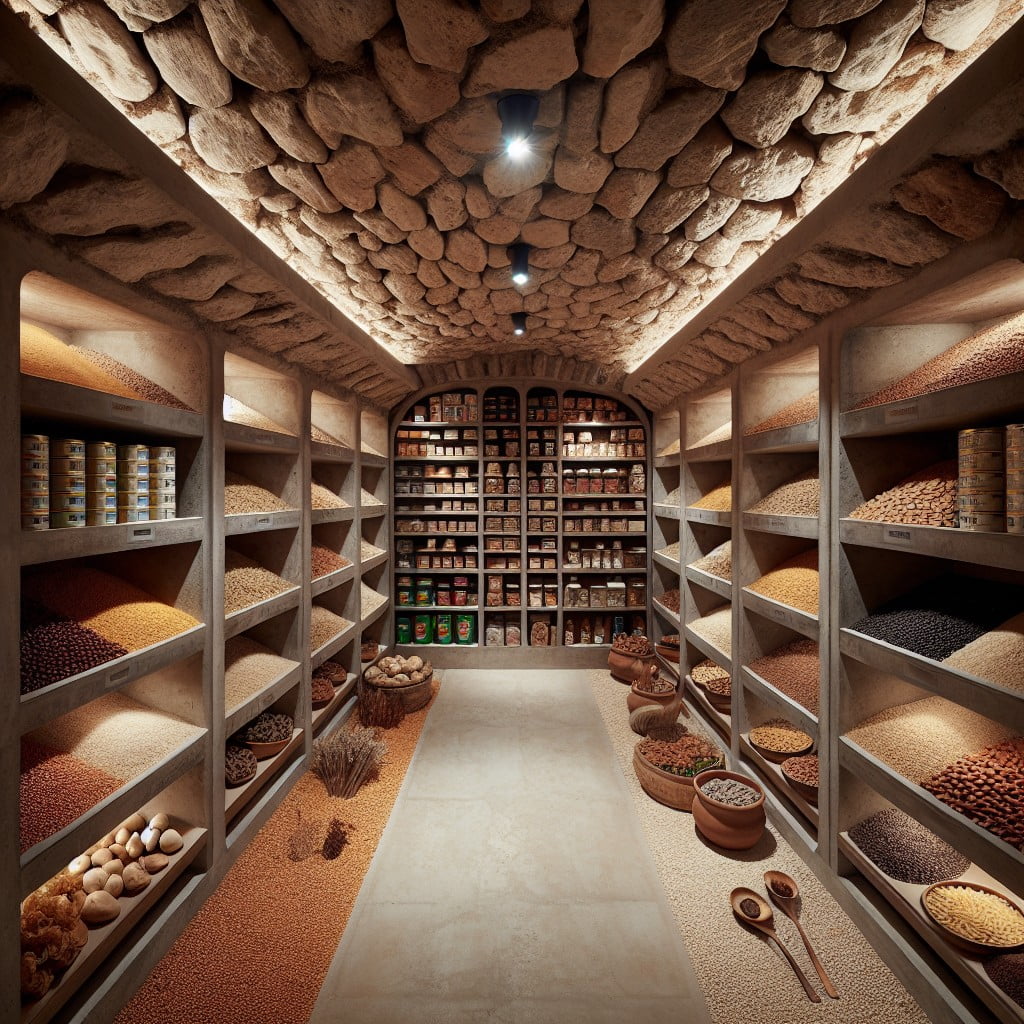
Emphasizing location selection can significantly impact pantry cooling. Where your pantry exists within your home can alter temperature regulation, primarily due to exposure to heat sources or cool areas.
Adjacency to hot areas: A pantry located next to a kitchen or a laundry room, both typically warm areas, could cause unnecessary heating, reducing the efficiency of cooling efforts.
Direct sunlight exposure: If your pantry has windows, those which face the sun for most of the day can cause a rise in internal temperature.
External walls and insulation: Pantries built against external walls might be affected by outdoor temperature changes, especially if these walls are poorly insulated.
Proximity to air conditioning vents: If the pantry is too far from AC vents, it may not receive adequate cool air, making it challenging to maintain a low temperature.
Taking these points into consideration during the initial planning and design stages can help mitigate these risks, leading to a pantry that’s efficient in its cooling, and perfect for long-term food storage.
Use of Insulated Doors in Pantries
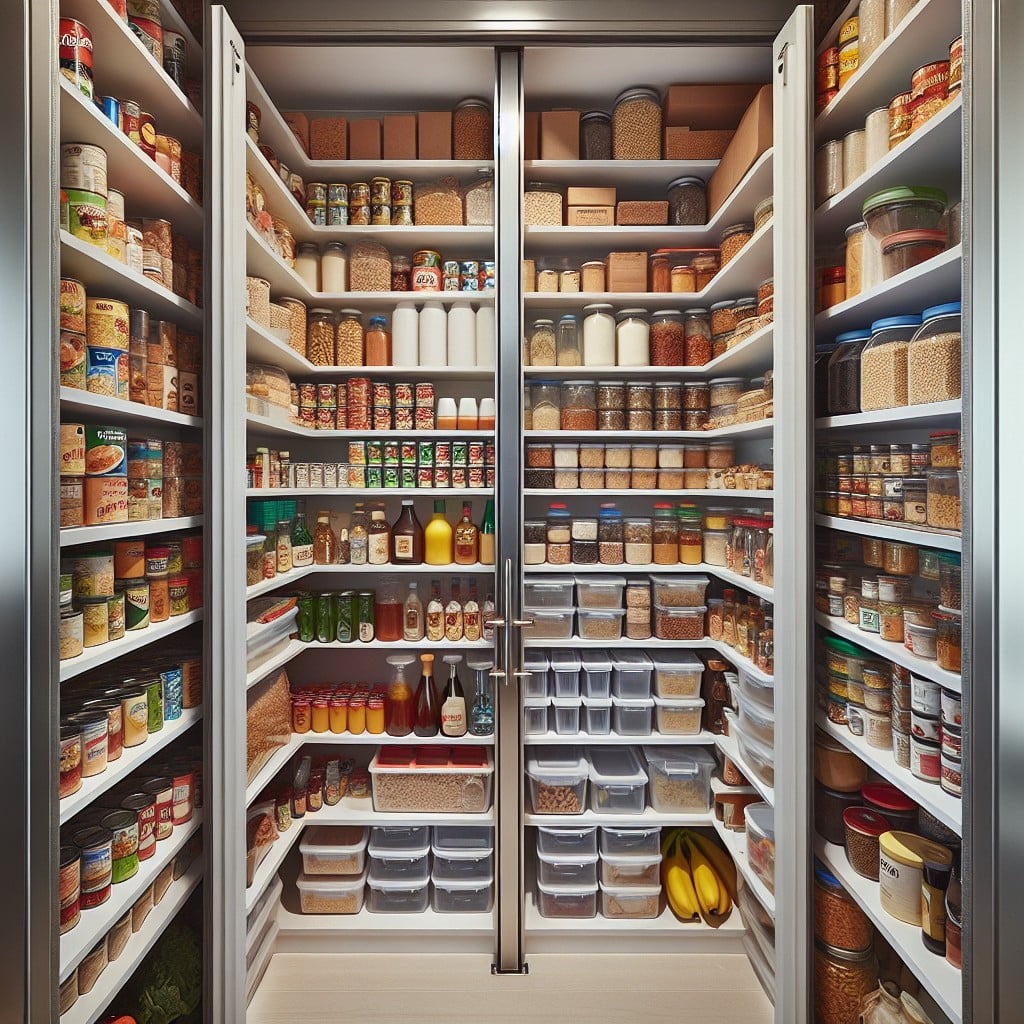
With a pantry, the door isn’t merely a barrier. An insulated door can provide many benefits for your pantry cooling needs. They serve a dual purpose; they trap the cool air inside and prevent warmer air from entering your pantry, which helps maintain a consistent temperature.
A variety of options are available on the market. Steel and fiberglass doors with inner foam insulation offer high energy-efficiency values. For a more traditional aesthetic, solid wood doors can also provide effective insulation, though they may require more regular upkeep.
Additionally, consider weatherstripping around the edges for an extra layer of insulation, this little detail can make a significant difference by reducing air leakage. Clear, plastic strip doors could also be used inside walk-in pantries for further temperature control whilst maintaining accessibility.
Overall, investing in an insulated door is an effective means to upgrade your pantry’s cooling capabilities. In the long run, it would save energy, maintain freshness, and potentially reduce waste.
Weatherstripping Pantry Doors for Increased Cooling
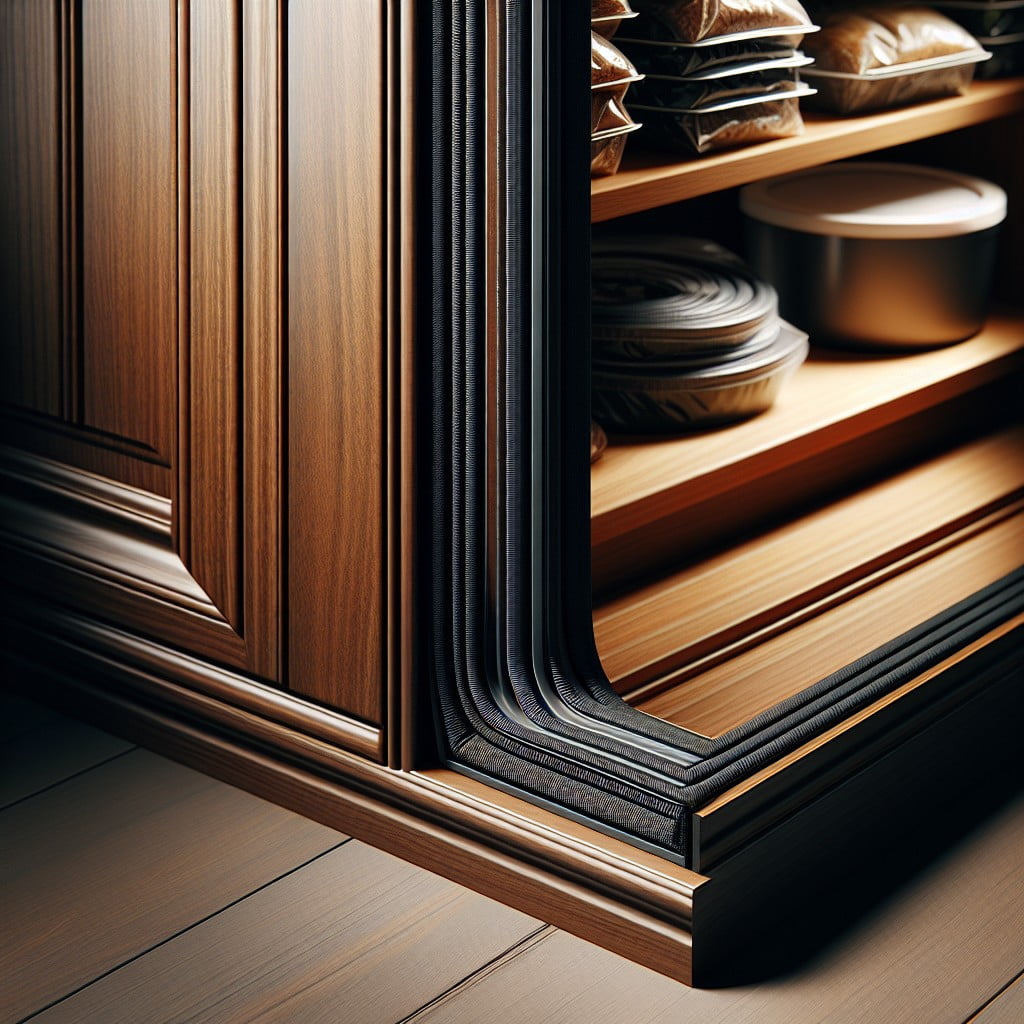
Weatherstripping is an efficient technique to enhance the cooling efficiency of your pantry. By applying this method, unwelcome warm drafts can be kept at bay and cool air inside the pantry can be preserved longer.
Let’s delve into the process a bit.
1. Material selection: Several materials can be used for weatherstripping – felt, foam tape, door sweeps, and V-strip or tension seal. Consider the exterior environment and your specific needs before opting for any specific material.
2. Technique: Regardless of the type of weatherstrip used, the approach remains the same. Apply the material to the door’s outer edges, ensuring it forms a tight seal when the door is closed to block warm air intrusion effectively.
3. Maintenance: Regular inspection of the weatherstripping is important for longevity, as constant door usage and variable temperatures may affect the material’s effectiveness over time.
A properly weatherstripped pantry door could be a simple and cost-effective solution to keep cool air locked in, ensuring your pantry remains at the desired temperature without any extra cooling efforts.
Guide to Cooling Appliances Suitable for Pantries
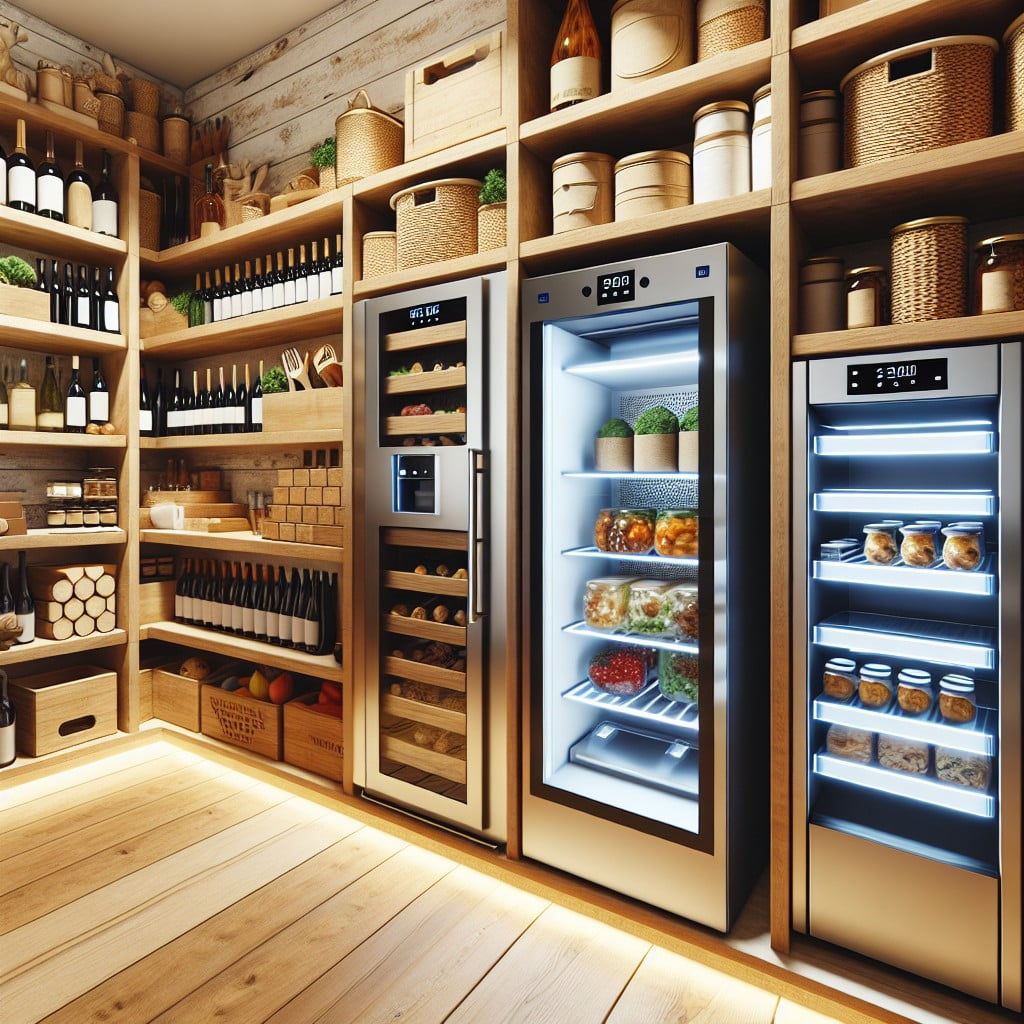
Selecting the right cooling appliance can not only regulate your pantry’s temperature but also extend the shelf life of your food.
Here’s what you need to consider:
1. Mini Fridges: Opt for compact and energy-efficient models that won’t overcrowd the space. They are ideal for storing dairy items or leftover food.
2. Wine Coolers: These are nifty if you’re a wine enthusiast. They maintain temperature and humidity at optimum levels, preserving the quality of your bottles.
3. Freezers: If your pantry space allows, you can opt for stand-alone freezers. These are great for storing meat, frozen vegetables, or any food items you bulk-buy.
4. Portable Air Conditioners: Small-scale units that can fit in a corner, cooling your pantry in the scorching summer months efficiently.
5. Dehumidifiers: These appliances aid in balancing the humidity level, ensuring a cool environment.
Speaking of energy consumption, remember to check the energy star rating of an appliance before purchase; higher ratings indicate reduced energy costs.
Ultimately, the choice depends on your pantry’s size, the type of food you store, and your budget.
The Role of Shelving in Pantry Cooling
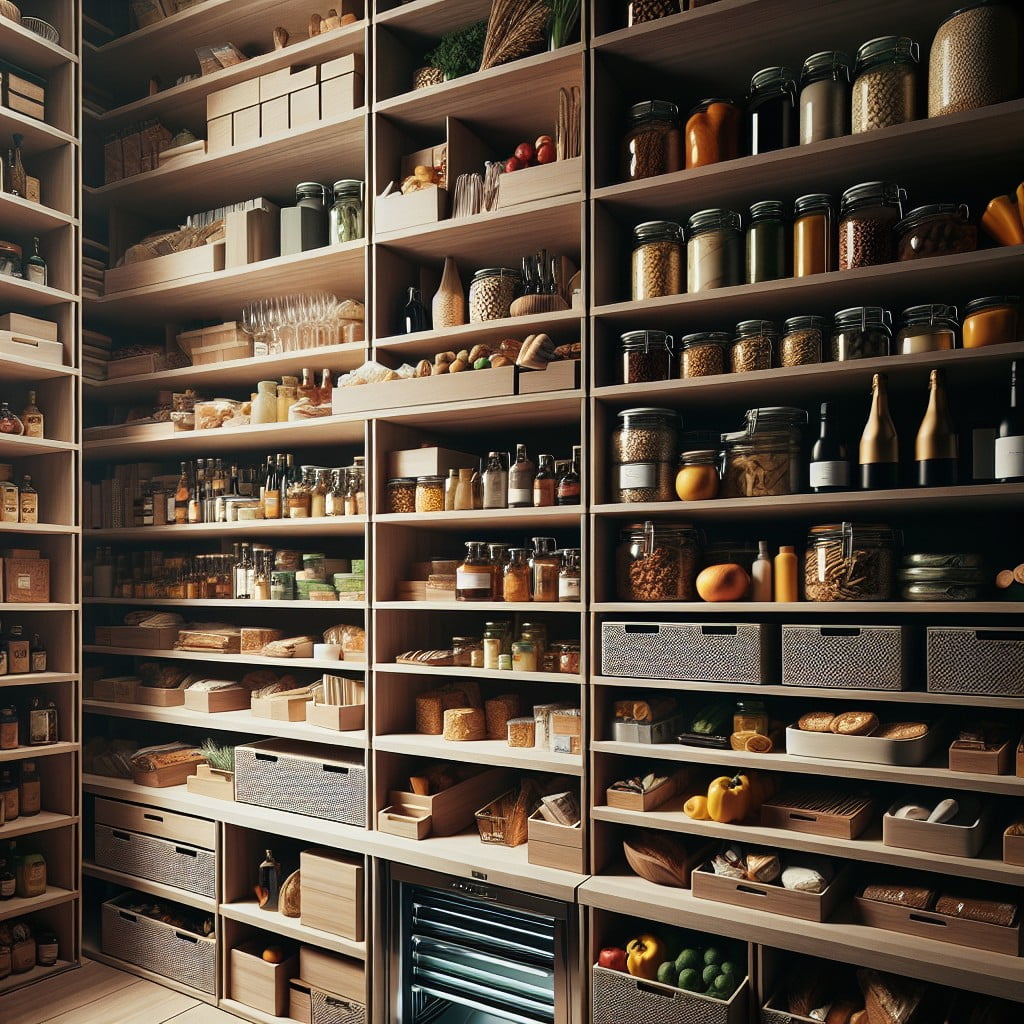
Resilient materials like metal and wire shelving are superior for maintaining a cool environment since they allow for better air circulation compared to solid wood or particleboard.
The gaps in wire shelving permit air movement, which cools items stored on all sides.
Design your shelving layout to ensure ample space between items for airflow.
Avoid overcrowding shelves as it impedes circulation and increases temperature.
Adjustable shelving is practical; it allows flexibility in spacing to accommodate different sized items while ensuring proper airflow.
Incorporating a pull-out drawer system also encourages air circulation and reduces dust and condensation build-up, translating to a cooler and cleaner pantry.
Always keep heavy items on lower shelves and lighter, heat-sensitive ones at the top, allowing for efficient heat management.
Remember, proper shelving plays a transformative role in a pantry’s temperature control.
Get Smart: Using Tech for Pantry Cooling
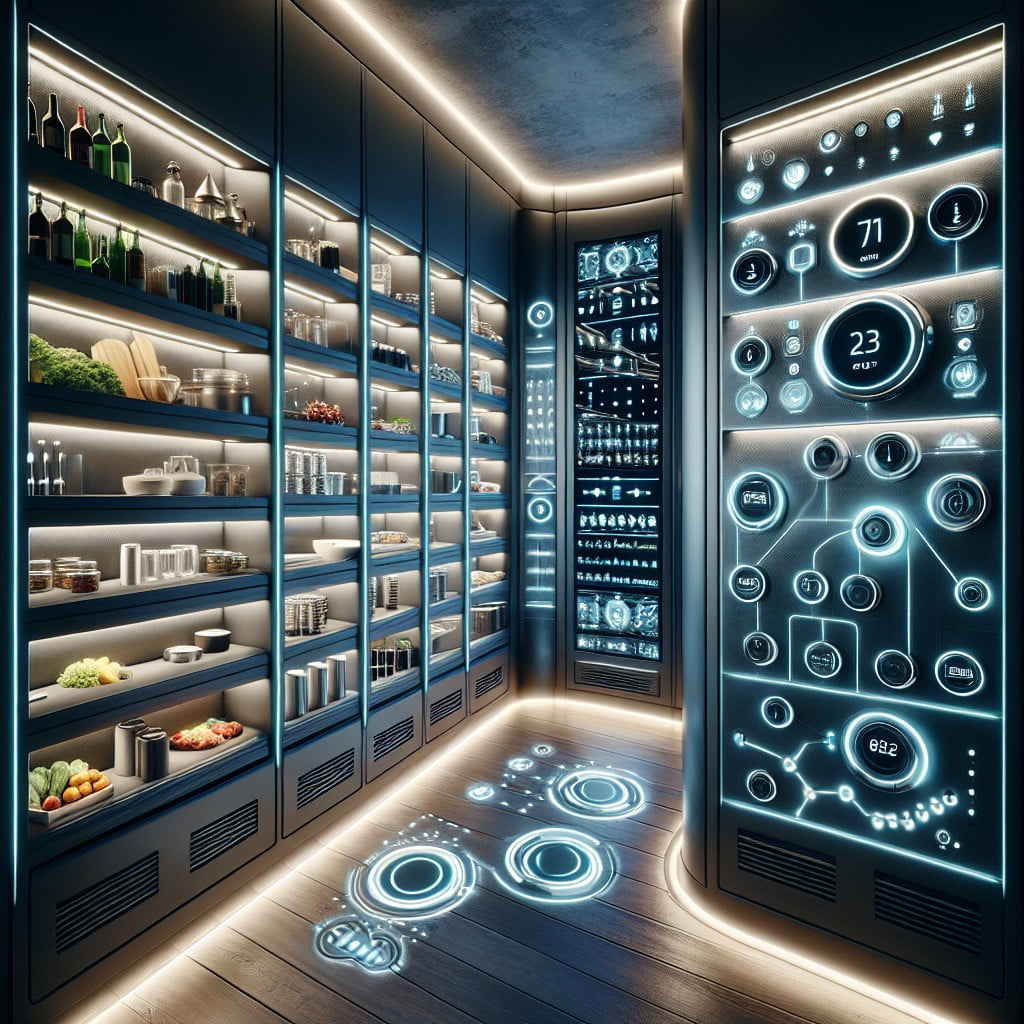
Innovative technological advancements now offer a range of solutions for maintaining the perfect pantry temperature. A smart thermostat, for instance, is excellent for monitoring and adjusting your pantry’s temperature as needed, ensuring optimal freshness and longevity for your stored goods.
Consider installing digital hygrometers, which can help track humidity levels. This is especially crucial if storing wine, to prevent corks from drying out and spoiling your precious vintages.
Smart vents, on the other hand, are perfect for managing airflow in pantries. They’ll allow fresh air in when needed, and shut tightly when necessary, thereby preventing unnecessary heat build-up.
Lastly, there’s the potentially game-changing smart home integration. With assistants like Google Home and Amazon Alexa, you can voice-control your cooling devices. Imagine verbally reducing your pantry’s temperature while busy in the entirely different part of the house – convenience at its finest.
The Art of Pantry Breathability
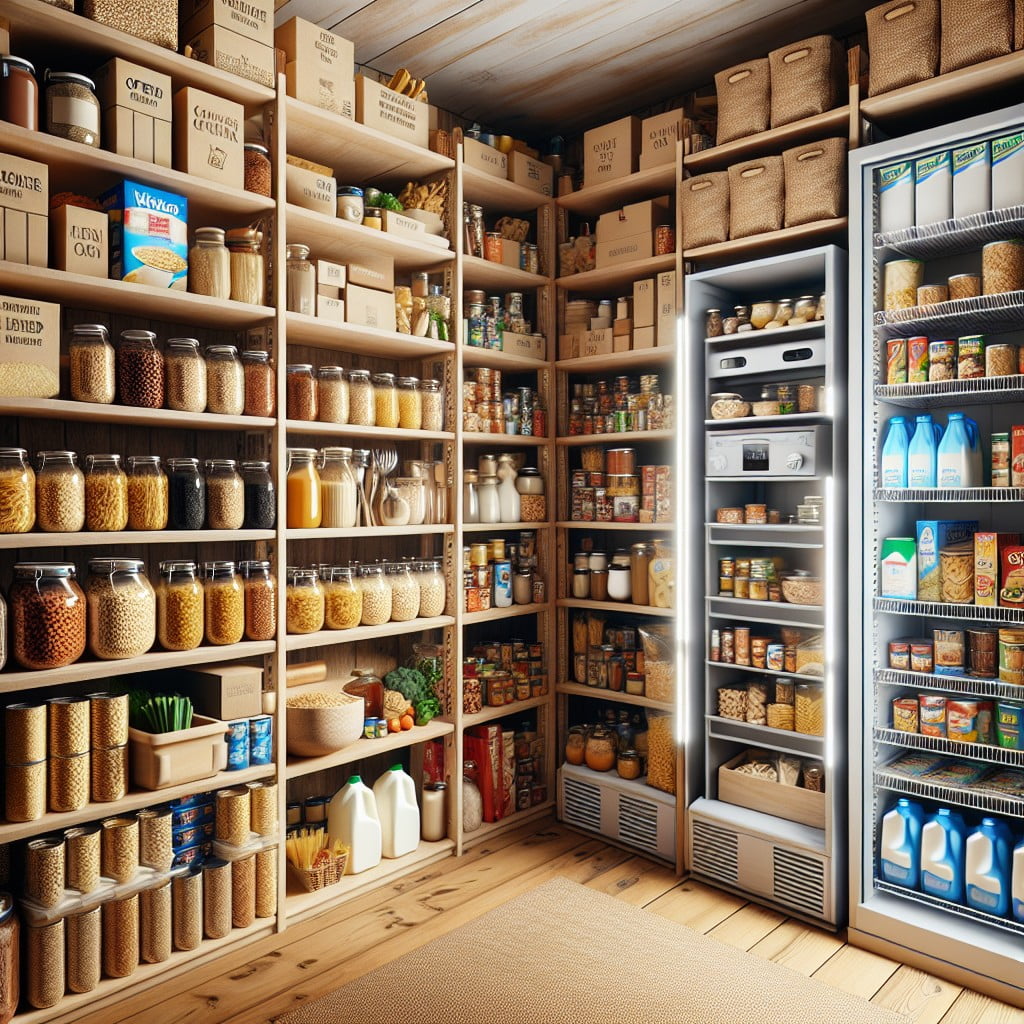
To embrace breathability in your pantry, start by creating ample circulation space. Here’s how:
1. Spacious Design: Leave enough room between pantry shelves. This provides an unrestricted path for air to flow, thus maintaining a cool temperature.
2. Use of Baskets: Instead of having all your items sitting directly on your shelves, consider using wire baskets. These allow air to circulate around your foodstuffs and prevent hot spots.
3. Ventilation: Incorporate small vents or grates in the pantry design. These aid in allowing warm air to escape, keeping the storage area cool.
4. Avoid Overcrowding: Overstocking shelves can block air circulation. Make an effort to only store what you need and rotate out older items to promote freshness.
Remember, a well-ventilated pantry contributes to preserving food quality.
A Look At Cooling-Friendly Pantry Layouts
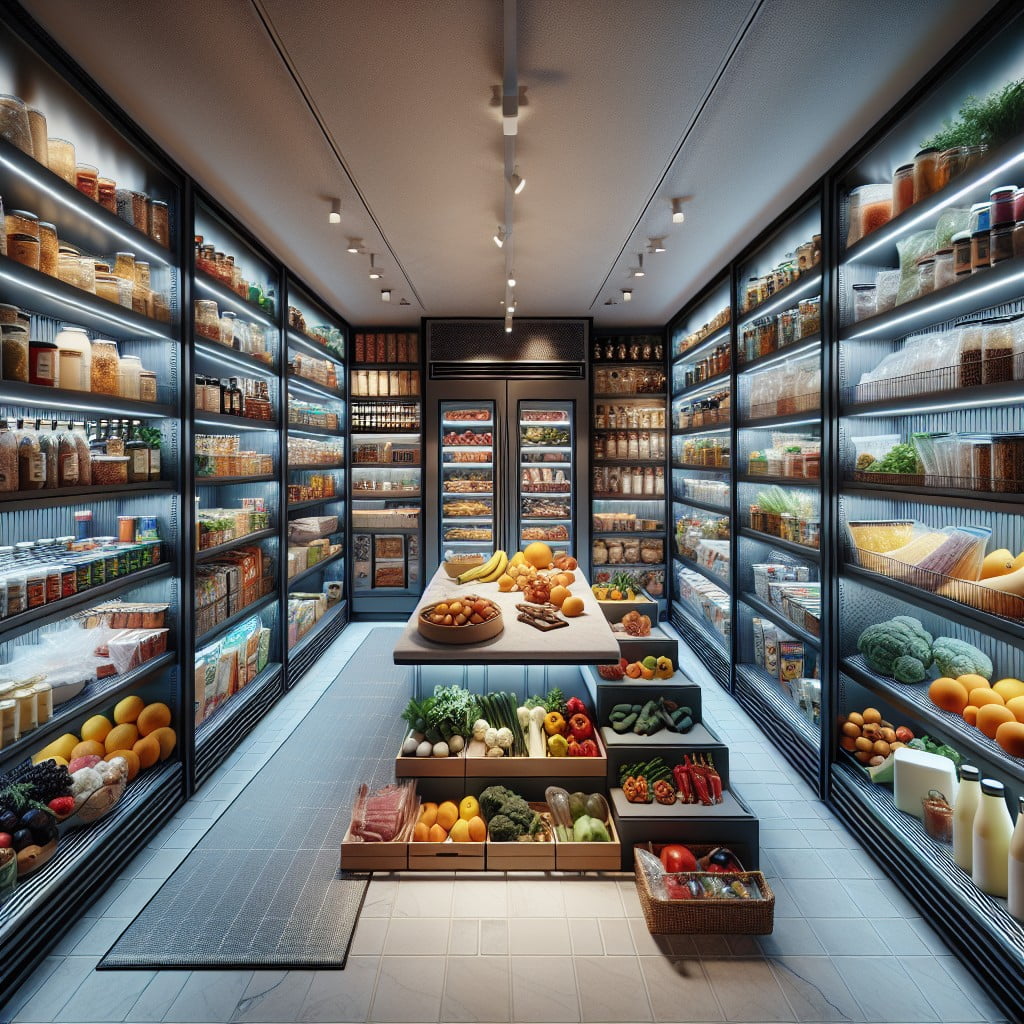
To create a pantry layout conducive for cooling, a couple of key considerations are in order.
First, spacious and open designs allow for improved air circulation. This reduces the chances of stale air pockets keeping some areas warmer than necessary. Strategic placement of shelves, ensuring that they don’t block airflow, plays a crucial part as well.
Next, walk-in pantries should ideally have an aisle width of 36 to 48 inches. This not only allows ease of movement but contributes to maintaining the ambient temperature.
Last but not least, placing frequently accessed items near the door minimizes heat introduction by reducing the time the door needs to be open.
In sum, efficient cooling starts with the layout – having ample space for circulation, appropriate aisle width, and practical item placement.
Managing Light Exposure for a Cooler Pantry
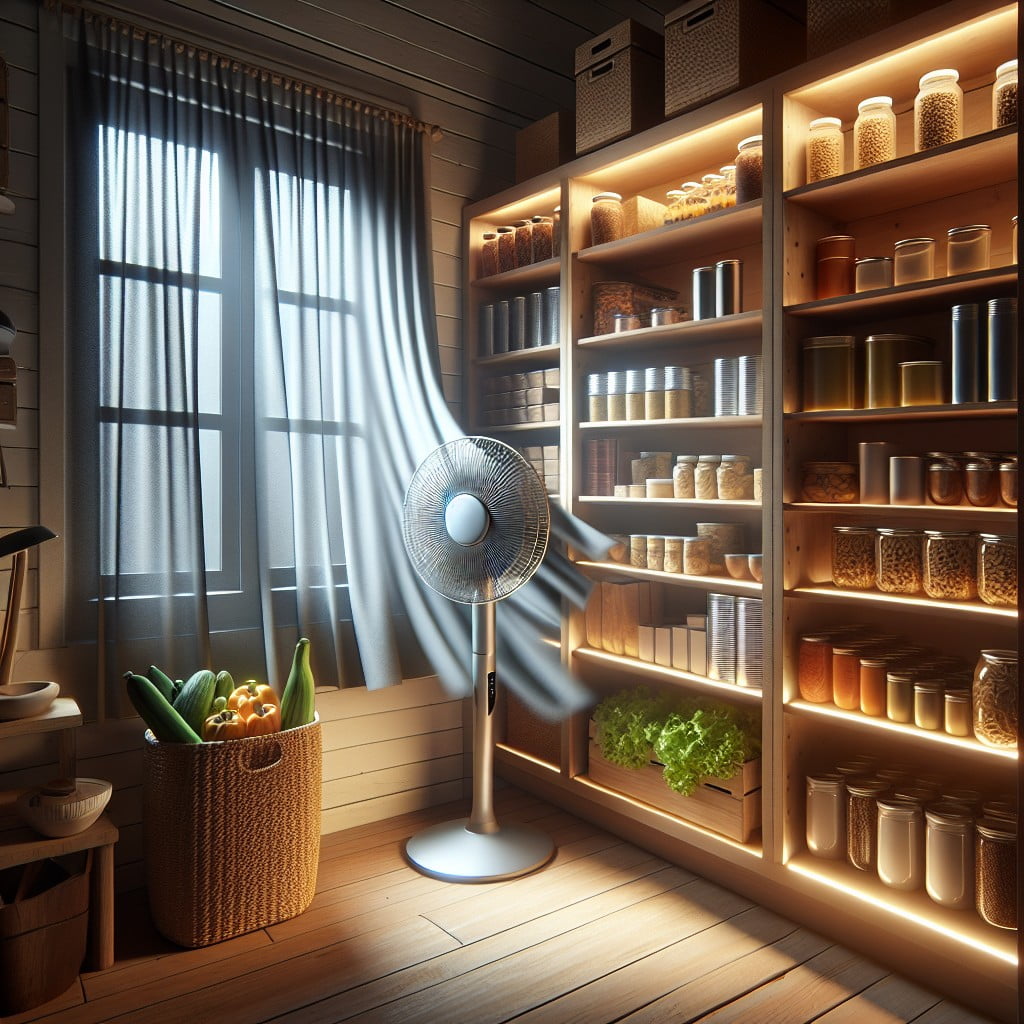
Utilizing blinds or curtains on any windows in or near the pantry can mitigate the impact of sunlight, lowering internal temperatures. As appealing as natural light may seem, it substantially heats the pantry, which can negatively affect the stored items’ longevity. Hence, blocking it out, especially during peak hours, is crucial. Light-colored or reflective window coverings can reflect solar radiation and reduce gain from direct sunlight.
Another element to consider is the type of light fixtures in use. It’s beneficial to opt for LED bulbs as they generate less heat compared to traditional incandescent lights.
Finally, consider investing in light timers or motion sensor lights, as these can significantly reduce the duration your light is on, subsequently leading to less heat production. Both will keep the space sufficiently lit while minimizing any unnecessary heat generation.
In essence, with minimal modifications and mindful choices, you can effectively manage light exposure in your pantry to keep it cooler.
Heat Control and Insulation Techniques in Pantries
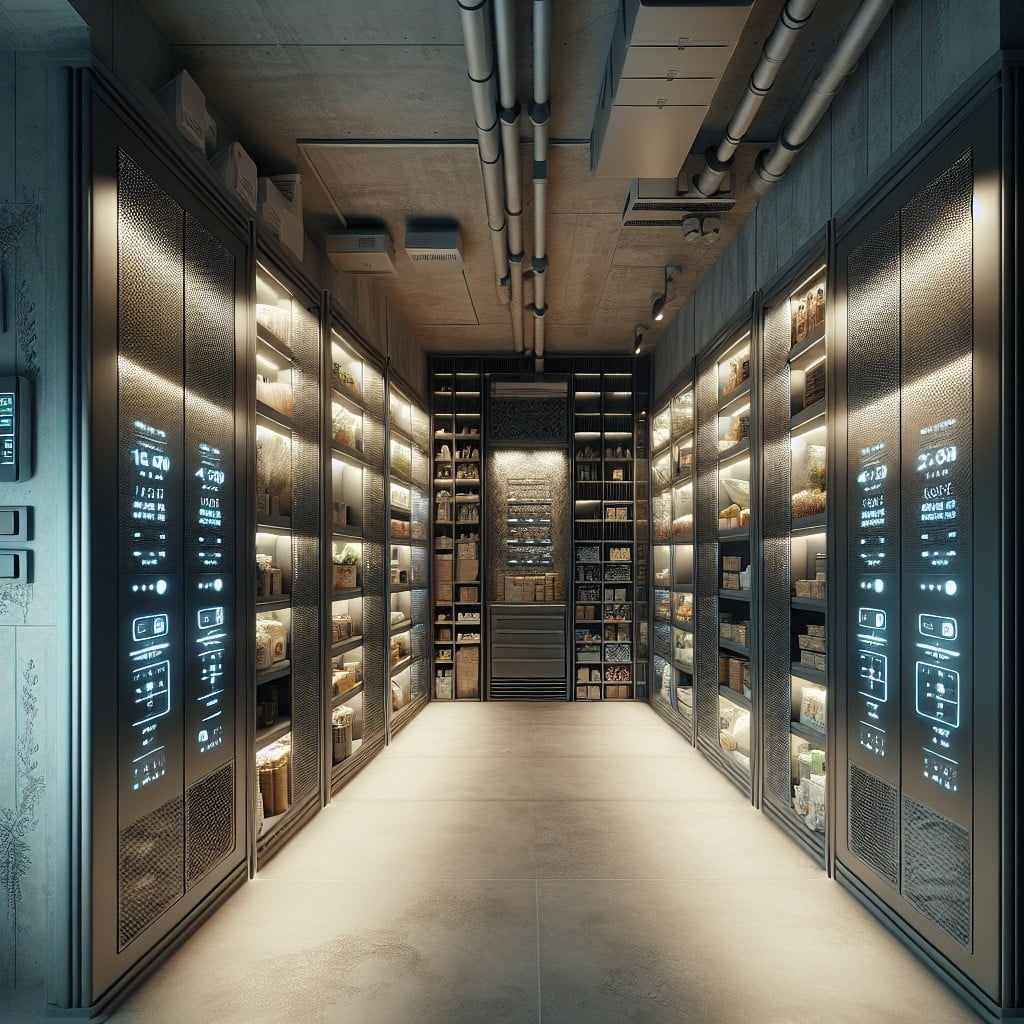
For favorable pantry conditions, insulation is a must, blocking out excess heat from adjacent spaces, such as ovens or dishwashers. Some effective materials include foam board and spray foam insulation. A pantry on an exterior wall may benefit from double insulation layers for increased protection against heat.
Reflective insulation is another excellent choice, particularly for attics or under roofs as it stops radiant heat. The silver side facing outwards deflects heat, while reducing cooling loss.
Another technique involves the strategic use of insulating curtains or blinds. These work like insulation for your windows, keeping out heat while maintaining the pantry’s cool internal temperature. For pantries adjoining the kitchen, consider using a well-insulated door to maintain a cool barrier.
Proper ventilation, like installing a vent to the outside or an attic, lets hot air escape while cool air circulates. For extreme cases, a small cooling unit might be beneficial.
Lastly, it’s crucial to routinely check and seal any gaps or cracks around doors, windows, and near pantry ceiling and floor that may be allowing heat to seep in. Weatherstripping and caulk could effectively stop these leaks.
Remember, combination techniques often work best when aiming to maintain an optimal pantry temperature.
Ideas Elsewhere
- https://www.homesandgardens.com/kitchens/how-to-keep-a-pantry-cool-in-hot-weather
- https://bienalclosets.com/pantry-ventilation-tips
- https://diy.stackexchange.com/questions/95188/how-can-i-help-pantry-cabinets-stay-cool
- https://forums.whirlpool.net.au/archive/1990208
- https://remodelreality.com/kitchens/how-to-keep-a-pantry-cool/
- https://budgetfriendlyfurnishing.com/how-to-cool-down-a-pantry-easy-guide/
- https://storables.com/interior-design/how-to-keep-a-pantry-cool-in-hot-weather/
- https://www.masterclasskitchens.co.uk/inspiration/kitchen-storage-ideas/hot-pantries
Recap:




